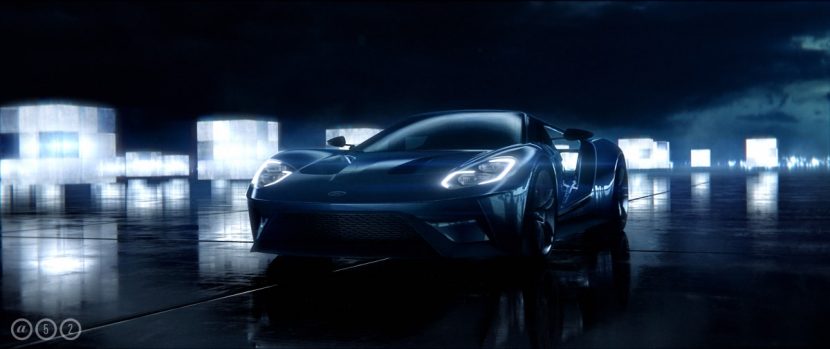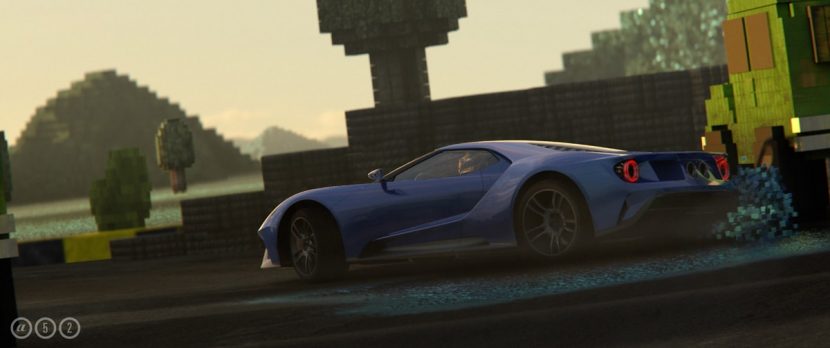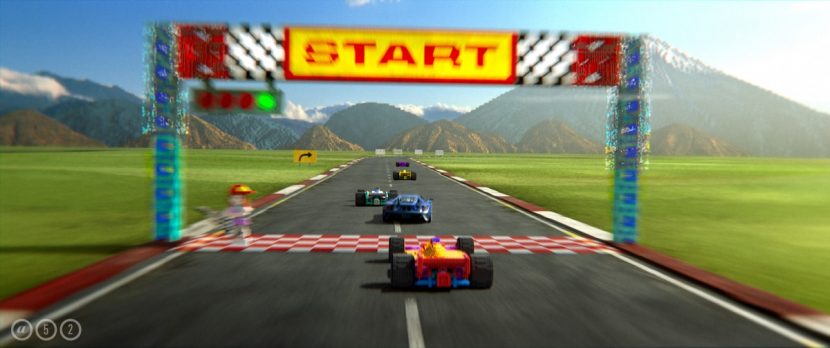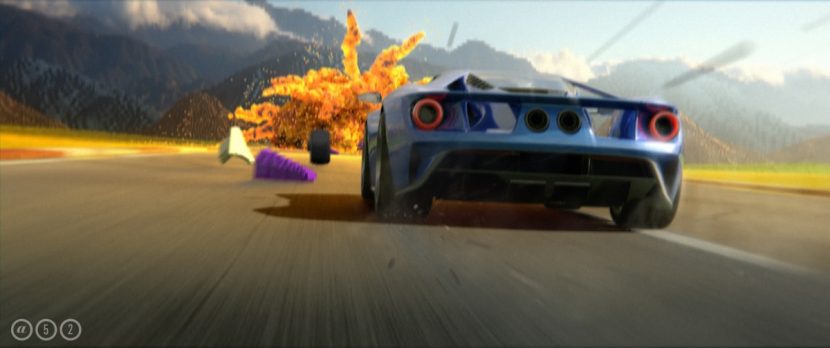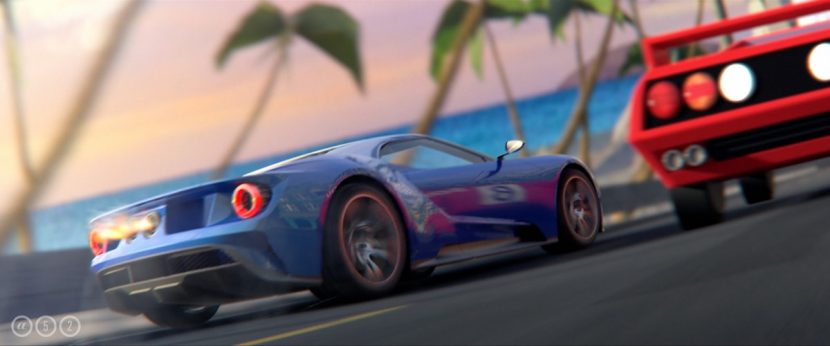Forza Motorsport 6 has just been released on Microsoft Xbox, with the game series celebrating its tenth anniversary. As a mark of Forza’s influence on car racing, a promo spot featuring the 2017 Ford GT was also released, taking viewers through a history of iconic car games – from Gran Trak 10, RC Pro-Am, Pole Position, Chase HQ to Ridge Racer and finally Forza 6. a52 is the studio behind the work, and we asked them how they made this classic spot.
fxg: Can you talk about your brief for the spot? How was the spot broken down in terms of concepts/boards/animatics?
VFX Supervisor Andy McKenna: We worked very closely with Director Michael Spiccia during the pitch phase of the Forza Motorsport 6 spot, helping to develop the early ideas for the look of the worlds as well as the very early brainstorming on how to best capture an authentic racing feeling which was very important to Michael.
Once awarded, Pre-production included conversations with Michael regarding a deep and extensive exploration of the look and actions in the spot. It was important to Michael and the agency (two fifteen mccann) that we end up shooting these worlds with a dynamic cinematic language that people had never seen applied to vintage games before. Merging with that we also needed to obey the limitations of the games. It was very important to Michael to give a sense of evolution through the journey, but also to communicate the specific games quickly. He wanted to use a dual approach in the cinematography that would keep the spot modern, exciting and visceral, but also connected with the ethos of the original game.
We carefully and extensively pre-vised every scene in the film and we discussed the best plan for executing Michael’s vision, which took note of some of the best race car sequences from feature films of the past as reference.
fxg: How was the initial environment (that’s revealed as the black and white game) and the vehicles realized?
McKenna: Each world was based on an iconic racing video game from the past. This first world was based on Gran Trak 10 which was a two dimensional game – viewed/played only from overhead in a 2 dimensional view. Michael wanted to inject viewers into all of these worlds as if they actually existed, in a three dimensional way. The fun was designing worlds that acknowledged and connected instantly with the past but in a revolutionary way. Michael tasked our designers with retaining the key elements of each game world, their unique spirit and details, but he wanted to grow them into completely immersive realms, from perspectives which elevated each world to a whole new level of imagination and excitement.
Michael also wanted our design language to evolve with the progressive history of racing games. So where Gran Trak 10 consists of each individual pixel in a simple but beautiful (now 3D) world, proceeding game worlds would also evolve, increasing in complexity. For instance the next game world, R.C. Pro-Am, contains objects designed from 20 pixels or blocks. Then in Pole Position we see objects that are now made up of 100 pixels…..and so on until we reach the gorgeously rendered Forza 6 Motorsport 6 game world.
fxg: There’s some stunning racing and cinematography in the desert/cactus world – how did you approach the actual virtual driving?
McKenna: Motion capture was a solution that we initially considered for this job but Michael and the agency really wanted to shoot the actual 2017 Ford GT car through an anamorphic lens, simulating camera moves that would be captured from a pursuit or chase car.
Using our Previz as the starting point Michael filmed the real 2017 Ford GT with anamorphic lensing, which provided a wide array of looks for us to use in the end piece. The real 2017 Ford GT car was mounted on a hydraulic gimble which rotated on 3 axis and varied in height as the camera made sweeping passes over it. This simulated performance footage of the car which related back to the previs for screen direction and terrain variations. The challenges for tracking were to map the car’s orientation as well as the camera track, as they were moving independently of each other. We eventually placed the car into various landscapes and styles of game play, so we had to tent the on camera set, to eliminate reflections in the paint. We also used gobos to light the car with ambient light so we could map environments and reflections back into the paint.
Thus what we ended up doing was using a combination of disciplines – live action; CG; match moving and lots of compositing to maximize each moment during our race. We ended up with very authentic camera language and our Forza sits perfectly into the wide array of environments. Despite all the technical challenges, it was a wonderfully nostalgic ride for all of us, that was a lot of fun to create.
Head of 3D Kirk Shintani & CG Supervisor John Cherniack: One thing that we put emphasis on is the camera, and we spent a lot of time making sure the cameras felt right. We tracked actual race footage in order to maintain the grounded feeling of a camera that dips, wobbles and vibrates. It’s a small thing, but it does make a huge difference in the feel of the shots. As artists, we all try and take the “perfect” out of models and textures in order to make them feel more real. A camera is no different. While adding things like procedural noise and scripted randomness to the motion within Maya helps take the edge off, there is still something artificial about the way it FEELS. Having a camera track of actual race footage adds a natural organic quality to the motion. Because we were trying to emulate classic games, we animated the cars by hand. This allowed us to stylize the action, and push the motion to get the performance we needed in each shot.
fxg: When it switches to the pixel/voxel world, can you talk about setting up the challenges there?
Shintani and Cherniack: The biggest challenge for us was to create a method of generating the pixels in a way that was flexible and allowed us to make adjustments easily. There are brute force ways of creating this look, but this would lock us into a specific shape, size and color. We wanted to be sure we were able to quickly make changes in order to maintain the quality of the visuals. We ended up writing custom scripts via SOUP to generate the blocks on a per object basis, which allowed us to adjust the size, shape and color of the blocks on the fly within Maya. This also allowed us to adjust the blocks per vignette, depending on the needs for the particular game we were recreating.
Our methodology was to follow a standard workflow for all of the assets, then apply and adjust the scripts to tweak the pixel look. Viewers might not catch it, but most of the environments are made of pixels as well. We also wrote tools to “wipe” blocks for some of the transition elements as well as a custom UV UDIM generator to help us sort through all the geo and make it usable from a texture perspective. From there, we published out VRay proxies of the assets to shift the heavy lifting to render time.
fxg: In particular, how was the voxel explosion accomplished?
Shintani and Cherniack: The explosions were a multi step process. The initial sim was done in Maya in a traditional manner, in this case with Maya fluids. Once we had a sim that we were happy with, this was converted into geometry and we then ran our custom scripts to generate the pixels. The sim drove the shape and motion of the blocks, essentially acting as a container We then used several different outputs of the fluid to drive the color of the individual blocks, which allowed us to maintain the spirit and look of the initial sim, but render it as pixels with full color information.
fxg: The final areas show improved graphics – can you talk about the overall rendering and lighting approach in each game re-creation?
Shintani and Cherniack: The technical approach for all of the vignettes was basically the same. Proxy everything, We use VRay, and it did a great job at pushing higher poly counts through pretty quickly. In terms of aesthetics, each iconic game needed it’s own unique look, so we tried to shift lighting, saturation, and intensity to help separate each vignette. Some vignettes like Gran Trak 10 were more stylized just by the nature of the elements that exist in the game. Since this environment was very dark, we wanted to be sure the pixel “cube lights” had a nice feel and gave us enough to ping the 2017 Ford GT. We re-skinned the car in some shots in order to add reflections and lighting to seamlessly fit it into the environment, while other shots were full CG. The floor turned out to be one of the more important elements in this sequence because it gave the space a sense of scale, and grounded the elements.
Other games naturally were much more realistic and had more detail. Chase HQ and Ridge Racer for instance. In Chase HQ, we wanted to be sure it felt like a hot desert road, and treated it much more traditionally while Ridge Racer was Miami inspired. For RC Pro-Am and Pole Position, there was a noticeable “pixel” effect. So while we lit it normally, we needed to make sure that we popped the cubes so the effect read clearly on first viewing.
Once all of the renders were dialed in and looking good from CG, everything was then pushed and developed even further in composite. This is where the balance between real and hyper real was struck. Lens flares, sky integration, environment haze, DOF and lots of love were used extremely effectively to ground each vignette and bring the spot into this “hybrid” world of classic video game nostalgia, and cutting edge photo real modern gaming.

